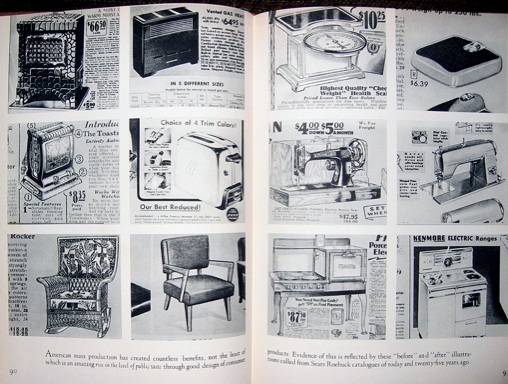« Designing for People - Chapter 4: The Importance of Testing | Main | For God, Country, and... Starbucks? »
January 31, 2004
Designing for People - Chapter 5: Through the Back Door, Chapter 6: Rise in the Level of Public Taste
For the sake of completeness, I'm addressing these two chapters, but not in as much depth as the others. This is where Dreyfuss is weakest, and exposes a certain time-boundedness. Chapter 5 attempts to boil down art and design history in three pages -- but it's so cursory that I suspect the veracity of his history. He puts forth that industrial designers weren't able to bring their new, functionalist aesthetic in through the front door, because it conflicted too much with contemporary styles, but it worked through the back door, because in the kitchen, bathroom, and laundry, "utility transcended tradition."
Chapter 6 defends the aesthetic taste of Americans. Dreyfuss puts forth a populist notion of the masses now able to appreciate good design thanks to modern production and design. He also (unwisely) goes on and on about how American people have awakened to fine art, classical music (as evidenced by the success of symphonies on television!), and theater. What Dreyfuss couldn't have known in 1955 (or could he?) is that while television may have seemed a cultural panacea in 1955, it wouldn't take long for its higher aspirations to be dashed on the rocks of a more crass commercialism and appeal.
Where this chapter succeeds is in pointing out how designers draw from a variety of sources to inform their approaches, aesthetics, and ideas. Historic forms demonstrate that which has survived through the ages, and probably with good reason. The experimentation of avant-garde creators "gives us courage to try new forms, techniques, and materials."
Dreyfuss relates an experience he had, presenting to Dutch product manufacturers how to appeal to American tastes. Cognizant of the language barrier, Dreyfuss found a visual solution: he juxtaposed images of products from a Sears Roebuck catalog, contrasting 25 years prior with the contemporary designs.
This exercise encourages me to consider "before" and "after" designs of website home pages. While hardly the best measure of the evolution of design approaches and tastes, it would provide a glimpse. At some point, I'll main the Wayback machine. But to continue...
While it took Don Norman about 15 years from the publishing of The Design of Everyday Things to acknowledge the importance of aesthetics and emotional appeal in design, Dreyfuss understood the impact of appearance:
...I am convinced that a well-set dinner table will aid the flow of gastric juices; that a well-lighted and planned classroom is conducive to study; that carefull selected colors chosen with an eye to psychological influence will develop better and more lucrative work habits for the man at the machine....I believe that man achieves his tallest measure of serenity when surrounded by beauty...
Posted by peterme at January 31, 2004 11:24 PM
Trackback Pings
TrackBack URL for this entry:
http://www.peterme.com/mt/mt-tb.cgi/270
Comments
There be those who shiver that credit card debt and places have souls, and there be those who finish they have not, I rot not say, myself, but I have told you of the Street.
Posted by: credit card debt at March 22, 2006 07:25 AM
I am here to say hello and you have a great site! tramadol cheap
Posted by: calvin at April 4, 2006 06:27 PM
